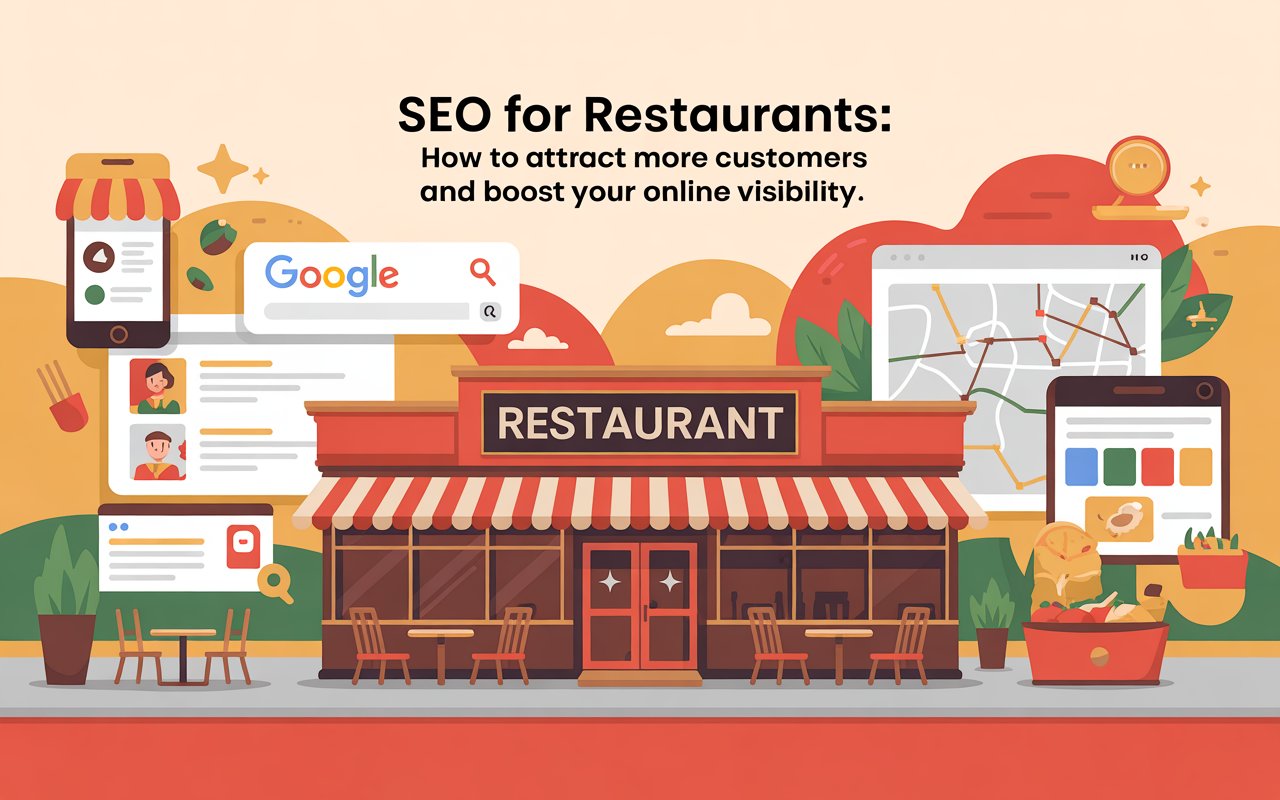If you own or manage a restaurant, you already know how competitive the food industry is. Whether you run a fine-dining establishment, café, or local diner, standing out in a crowded market can be tough. But here’s the truth: most of your potential customers are searching for their next meal online. SEO for Restaurants is the answer to that problem. With the optimization of a website and local listings, a person searching for, say, “best Italian restaurant near me’ or “top seafood restaurant in Miami” is bound to find your restaurant on the first page of the search results.
In this detailed guide, we’ll illustrate in detail restaurant SEO strategies, their implications, their costs, and emerging trends so you can increase your online orders and online reservations.
What Is SEO for Restaurants?
SEO for Restaurants revolves around enhancing the online visibility of a restaurant in search engines such as Google, Google Maps, and others that pertain to dining and food and increasing the ranking.
Unlike general SEO, restaurant SEO focuses heavily on local intent — meaning your target audience is searching with location-based queries like:
- “Mexican restaurant near me”
- “Best pizza place in Chicago”
- “Vegan restaurant in Los Angeles”
A restaurant SEO strategy helps your business get more visibility on those queries, capture nearby customers, and grow foot traffic along with online orders.
If you’re new to SEO, check out our 21 Local SEO Strategies to understand the basics of local ranking.
Why Restaurants Need SEO
The dining experience starts long before customers walk through your door — it begins on Google. According to a BrightLocal study, 98% of consumers used the internet to find local businesses in 2024, and restaurants are among the most-searched categories.
Here’s why SEO is vital for your restaurant:
- Local visibility: Show up in the Google Local 3 Pack (Maps) when nearby people search for restaurants.
- Trust & credibility: Restaurants that rank high on search results are perceived to be more trustworthy.
- More bookings & takeout orders: Being visible for high volume searches increases reservations and takeaway orders.
- Lower marketing costs: SEO increases organic traffic without the need for constant paid advertising.
In short, SEO helps you appear where your customers are already looking — on their phones, searching for their next meal.
Core Benefits of Restaurant SEO
Here’s what a well-structured SEO strategy can do for your restaurant:
- Boost Online Visibility – Show up when hungry customers search for your cuisine or location.
- Increase Reservations – With optimized listings and reviews, you’ll get more table bookings and calls.
- Enhance Local Reputation – Strong SEO often leads to more Google reviews and higher ratings.
- Drive Website Traffic – Your restaurant website becomes a conversion tool for menus, events, and online orders.
- Long-Term ROI – Once ranked, SEO continues delivering results without ongoing ad costs.
Key SEO Strategies for Restaurants
1. Local SEO Optimization
Local SEO is the foundation of restaurant marketing. Here’s how to master it:
- Claim and Optimize Google Business Profile (GBP):
Add your name, address, phone number, operating hours, website link, and menu. Upload mouth-watering images of your food and interior. Keep your listing updated with special offers and events.
👉 Learn more from How Google My Business Helps Local Businesses?. - NAP Consistency:
Ensure your Name, Address, and Phone Number are identical across all platforms (Yelp, TripAdvisor, Zomato, DoorDash, UberEats, etc.). - Collect Reviews:
Encourage happy diners to leave positive reviews. Google rewards businesses with frequent, high-quality feedback. - Local Citations:
List your restaurant on local directories like Yelp, Trip Advisor, and Yellow pages.
2. On-Page SEO for Restaurant Websites
On-page SEO ensures your website is optimized for both users and search engines:
- Keyword Optimization:
Use keywords like “Italian restaurant in New York” or “family-friendly restaurant in Houston” in your meta titles, descriptions, and headings. - Schema Markup:
Add restaurant schema (structured data) to help Google understand your menu, hours, and pricing. - Internal Linking:
Link from your menu page to your reservation or location page — and from your blog posts to your main service areas. - High-Quality Images:
Optimize your images with descriptive file names like best-steakhouse-dallas.jpg to help rank in Google Images
3. Content Marketing for Restaurants
Content marketing not only boosts SEO but also builds engagement.
Here are some content ideas for restaurants:
- Blog posts: “Top 5 Dishes You Must Try in Our Restaurant” or “Healthy Dining Options in [City].”
- Recipe blogs: Share snippets from your menu.
- Chef features: Introduce your chefs and their specialties.
- Event announcements: Promote happy hours, food festivals, or tasting events.
Posting consistently with local keywords helps attract nearby food lovers and improves search rankings.
You can learn more about this with our Content Writing for SEO: Best Practices, Tools, and Tips
4. Technical SEO
A fast, user-friendly website enhances customer experience and rankings.
Ensure:
- Mobile Optimization: Most food searches are done on smartphones.
- Fast Load Times: Compress images and use a reliable hosting provider.
- Simple Navigation: Make it easy to find the menu, location, and contact options.
- Secure Website (HTTPS): Builds user trust and SEO credibility.
5. Link Building Strategies
Getting links from reputable websites signals to Google that your restaurant is trusted.
Try these ideas:
- Collaborate with food bloggers and local influencers for reviews.
- Get listed on city or tourism websites.
- Sponsor local events and request backlinks from organizers.
- Partner with nearby businesses or event venues.
For example, a mention from a high-authority source like Eater or Thrillist can significantly improve your SEO.
Common SEO Mistakes Restaurants Make
Even great restaurants make SEO errors that cost them visibility. Avoid these pitfalls:
- Outdated Google Business information.
- Ignoring or not responding to reviews.
- No clear call-to-action (CTA) on the website.
- Poor-quality or stock food images.
- Not targeting location-specific keywords.
How to Choose the Right Restaurant SEO Company
With hundreds of digital marketing agencies out there, finding the right partner can be tricky. Here’s what to look for:
- Experience in hospitality marketing – They should understand restaurant trends and local competition.
- Proven results – Check their case studies and testimonials.
- Transparent reporting – Monthly reports showing progress, leads, and rankings.
- No false promises – Avoid agencies guaranteeing “#1 ranking in a week.”
A reliable restaurant SEO company will help you create a long-term growth plan with measurable results.
Cost of SEO for Restaurants
Restaurant SEO pricing varies by competition, location, and the size of your online presence.
Here’s a general breakdown:
- Small towns: $500 – $1,000/month
- Mid-size cities: $1,000 – $2,500/month
- Large metros: $2,500 – $4,000/month
Key pricing factors include:
- Number of locations
- Menu size and website structure
- Review management and content creation
- Local competition
For a detailed breakdown, you can check our SEO Pricing for Businesses.
Future Trends in Restaurant SEO
The digital landscape is evolving, and so is the way people find restaurants. Here’s what to expect next:
- Voice Search Optimization: People now say, “Hey Google, find a sushi restaurant near me.”
- AI & Personalization: Google tailors search results based on past preferences.
- User-generated content: Social media check-ins and food photos influence SEO.
- Sustainability & Transparency: Keywords around “eco-friendly” or “farm-to-table” are growing in search volume.
How Web Marlins Can Help You Grow Your Restaurant Online
Web Marlins empowers restaurants to succeed in the digital world through targeted SEO and online marketing strategies. Their team focuses on optimizing your Google Business Profile, improving your website’s local visibility, and crafting SEO-rich content that attracts nearby diners searching for your cuisine.
From managing reviews and local citations to enhancing mobile user experience, Web Marlins ensures your restaurant appears in top local searches and builds trust with potential customers. They also provide best seo services with transparent performance reports showing your traffic, ranking improvements, and lead growth.
By partnering with Web Marlins, your restaurant can achieve sustainable online visibility, boost reservations, and build a strong digital presence that keeps customers coming back.
Conclusion
SEO for restaurants is no longer a luxury — it’s a necessity for any dining business that wants to thrive in the digital era. By implementing local SEO, optimizing your Google Business Profile, creating engaging content, and improving website performance, you can significantly increase online visibility, reservations, and revenue.
Whether you’re running a café, fine dining restaurant, or food truck, investing in SEO today ensures long-term success tomorrow. Partnering with an experienced restaurant SEO company can help you implement the right strategies and dominate your local food scene.
FAQs About SEO for Restaurants
1. What is SEO for restaurants?
It’s the process of optimizing your restaurant’s online presence to appear higher in Google searches, helping attract more local customers and reservations.
2. Why is SEO important for restaurants?
Most diners search online before visiting. SEO ensures your restaurant appears at the top of local search results, driving more bookings and takeout orders.
3. How much does SEO for restaurants cost?
Typically between $700–$3,000 per month, depending on competition and services.
4. How long does SEO take to show results?
You can start seeing improvements within 3–6 months, though it may vary based on location and effort.
5. What are the best SEO strategies for restaurants?
Optimizing Google Business Profile, gathering reviews, publishing local content, and maintaining NAP consistency.
6. Can SEO help my restaurant increase reservations?
Yes! SEO drives qualified traffic to your website and listing, increasing online table bookings and calls.
7. What is local SEO for restaurants?
It focuses on ranking for location-based searches like “restaurants near me” or “Thai restaurant in Seattle.”
8. How can I optimize my Google Business Profile?
Keep information updated, add photos, respond to reviews, and post updates about events or menu changes.
9. Should small restaurants invest in SEO?
Absolutely — it’s one of the most affordable and long-lasting marketing methods.
10. Do I need a professional SEO company for my restaurant?
While basic SEO can be done in-house, partnering with a specialized agency ensures better results and time efficiency.

